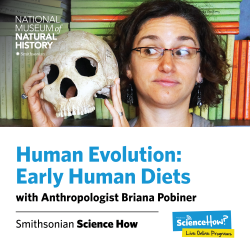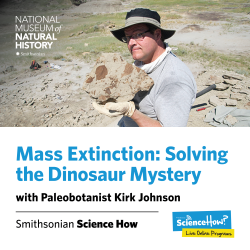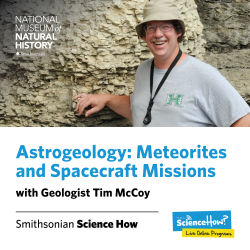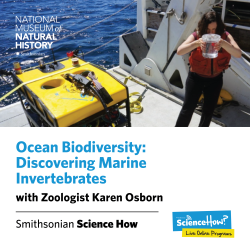Smithsonian Science How's collections
Human Evolution - Early Human Diets
<p>This Smithsonian Science How learning collection, from Q?rius at the National Museum of Natural History, is part of a distance learning program at <a href="https://naturalhistory.si.edu/education/distance-learning">https://naturalhistory.si.edu/...</a>. This collection focuses on the significance diet for human evolution. Targeted at middle schoolers, the collection invites students into an authentic understanding of the evidence for early meat-eating in humans. Anthropologist Dr. Briana Pobiner is featured as an expert explainer. The collection includes an interactive webcast video with discussion questions, cross-cutting activities, an independent project, and other resources for teachers and students.</p>
<p><strong>Key Terms:</strong> paleoanthropology, fossil, archaeology, human evolution, extinction, taxonomy, phylogeny</p>
<p><strong>Key Concepts:</strong></p>
<p>- What it means to be human</p>
<p>- Diet and culture of early humans</p>
<p>- Interpreting the family tree of humans</p>
<p>- Factors shaping human evolution</p>
<p>- Technology used by paleoanthropologists</p>
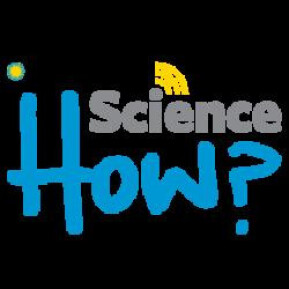 Smithsonian Science How
Smithsonian Science How
14
Mass Extinction - Solving the Dinosaur Mystery
<p>This Smithsonian Science How learning collection, from Q?rius at the National Museum of Natural History, is part of a distance learning program at <a href="https://naturalhistory.si.edu/education/distance-learning">https://naturalhistory.si.edu/...</a> This collection focuses on the end-Cretaceous extinction event that included dinosaurs. Targeted at middle schoolers, the collection invites students into an authentic understanding of the evidence for and causes of the mass extinction. Paleobotanist Dr. Kirk Johnson is featured as an expert explainer. The collection includes an interactive webcast video with discussion questions, cross-cutting activities, an independent project, and other resources for teachers and students.</p>
<p><strong>Key Terms:</strong></p>
<p><em>paleontology, dinosaur, fossil record, mass extinction, asteroid, Cretaceous period, K-T boundary</em></p>
<p><strong>Key Concepts:</strong></p>
<ul><li>Extinctions at the end of the Cretaceous</li><li>Causes of mass extinction events</li><li>Interpreting ecosystem changes through fossils</li><li>Reconstructing ancient environments</li><li>Technology used by paleontologists</li></ul>
 Smithsonian Science How
Smithsonian Science How
14
Astrogeology- Meteorites and Spacecraft Missions
<p>This Smithsonian Science How learning collection, from Q?rius at the National Museum of Natural History, is part of a distance learning program at <a href="https://naturalhistory.si.edu/education/distance-learning">https://naturalhistory.si.edu/...</a> This collection focuses on meteorites and related spacecraft missions. Targeted at middle schoolers, the collection invites students into an authentic understanding of meteorites as sources of information about our solar system. Geologist Dr. Tim McCoy is featured as an expert explainer. The collection includes an interactive webcast video with discussion questions, cross-cutting activities, an independent project, and other resources for teachers and students.</p>
<p><strong>Key Terms:</strong> geology, meteorites, asteroids, minerals, space missions, orbit, solar system history</p>
<p><strong>Key Concepts:</strong></p>
<p>- Evidence from meteorites about Earth's formation</p>
<p>- Characteristics of meteorites, meteors, asteroids</p>
<p>- Mineral origins of the universe</p>
<p>- Importance of space missions for astronomy</p>
<p>- Technology used by meteoriticists</p>
 Smithsonian Science How
Smithsonian Science How
13

